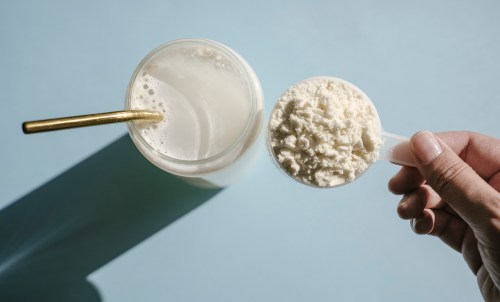For years, there’s been a general consensus that having too much fat in your diet can raise the risk of cardiovascular complications, including stroke. But the results of a new study suggest that’s not entirely true.
Experts in This Article
Fenglei Wang, PhD, is a postdoctoral fellow in the department of nutrition at Harvard’s T.H. Chan School of Public Health
director of cardio-obstetrics and internist at NYPH/Columbia
cardiologist and medical director of Non-Invasive Cardiology at MemorialCare Heart and Vascular Institute at Orange Coast Medical Center in Fountain Valley, California
Preliminary research presented at the American Heart Association’s Scientific Sessions 2021 found that, while eating higher amounts of red meat, processed red meat, and non-dairy animal fat increases your risk of stroke, eating more vegetable fat or polyunsaturated fat (found in foods like walnuts, sunflower seeds, and fish) actually lowers your risk.
The findings are based on a 27-year study of more than 117,000 healthcare professionals. The participants were 50 years old on average—63 percent were women, 97 percent were white—and none had heart disease or cancer when the study began. Participants filled out food frequency questionnaires every four years to help calculate the amount, source, and types of fat they had in their diets over the past year. The researchers then did calculations to help determine the participants’ long-term dietary intake and divided people into five groups (called quintiles) based on how much fat they ate.
During the study period, 6,189 participants had strokes. People who ate the highest amount of non-dairy animal fat were 16 percent more likely than those who ate the least amount of non-dairy animal fat to have one. But people who ate the most vegetable fat and the most polyunsaturated fat were 12 percent less likely to have a stroke than people who ate the least amounts of those fats.
Additionally, people who ate at least one serving of “total red meat” (which the researchers defined as beef, pork, or lamb as a main dish, in sandwiches, or mixed dishes) every day had an eight percent higher risk of stroke, and those who had a daily serving of processed red meat (like bacon, sausage, bologna, hot dogs, and salami) had a 12 percent higher risk. Overall, though, the researchers found that fat in dairy foods like cheese, butter, milk, ice cream, and cream was not linked with a higher risk of stroke.
It’s important to point out that the study was observational, meaning the researchers simply found that there is a link between people eating higher levels of animal fats and the risk of stroke. The findings don’t prove that eating a lot of animal fat actually causes the risk to go up.
In short: The study didn’t explore the why—it just looked at the overall link. Still, “Saturated fats found in meat are the likely culprit,” says Jennifer Haythe, MD, co-director of the Women’s Center for Cardiovascular Health at Columbia University Irving Medical Center and cardiologist at New York-Presbyterian/Columbia.
Jennifer Wong, MD, cardiologist and medical director of Non-Invasive Cardiology at MemorialCare Heart and Vascular Institute at Orange Coast Medical Center in Fountain Valley, California, agrees. “Meat—particularly red and processed meats—can be high in saturated fats,” she says. “Saturated fats have been known to raise the LDL (bad) cholesterol, and high LDL cholesterol can raise the risk for heart attack and stroke.” LDL cholesterol is also “known to increase inflammation” which can cause a build-up of plaque in the arteries—a common cause of stroke, Dr. Wong says.
OK, why might vegetable fats decrease your stroke risk
Vegetables have more monounsaturated fats and polyunsaturated fats, which can lower your levels of LDL cholesterol and raise the amount of HDL (good) cholesterol in your body, Dr. Wong says. As a result, it can decrease your stroke risk.
And, if someone is eating more vegetable fats, they’re also likely lowering the amount of animal fats they’re eating, she says.
How to lower your stroke risk
Lead study author Fenglei Wang, PhD, a postdoctoral fellow in the department of nutrition at Harvard’s T.H. Chan School of Public Health said in a statement that the findings should make people give their red meat-eating habits the side-eye. “Based on our findings, we recommend for the general public to reduce consumption of red and processed meat, minimize fatty parts of unprocessed meat if consumed, and replace lard or tallow (beef fat) with non-tropical vegetable oils such as olive oil, corn, or soybean oils in cooking in order to lower their stroke risk,” Dr. Wang said.
In general, “fats from vegetable sources are non- and poly-unsaturated fats, which may be protective,” Dr. Haythe says, making it a good idea to raise the amount of these fats you have in your diet. Dr. Wang also recommends doing your best to avoid foods that are high in saturated fats and aiming to eat at least five servings of fruits and vegetables a day.
Exercise is important, too, Dr. Wong says. “All of us should strive for a minimum of 150 minutes of moderate activity a week,” she says.
But Dr. Haythe notes that your stroke risk is about more than what you eat. “The risk of stroke depends on so many things including presence of diabetes, hypertension, smoking, obesity, sedentary lifestyle, and more,” she says. That’s why she tells her patients that the best way to live a long, healthy life is to eat a balanced diet “exercise, don’t smoke, limit alcohol, and control risk factors like hypertension and diabetes.” And, of course, if you’re nervous about your stroke risk, talk to your doctor. They can offer up personalized advice.
Oh hi! You look like someone who loves free workouts, discounts for cutting-edge wellness brands, and exclusive Well+Good content. Sign up for Well+, our online community of wellness insiders, and unlock your rewards instantly.
Sign Up for Our Daily Newsletter
Get all the latest in wellness, trends, food, fitness, beauty, and more delivered right to your inbox.
Got it, you've been added to our email list.











